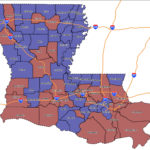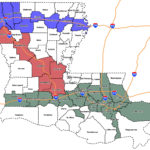While the US Census (which was last taken on April 1, 2010) is formally conducted every 10 years, the Census Bureau periodically posts population estimates for each county/parish. Earlier today, July 1, 2017 population estimates were released for each of Louisiana’s 64 parishes. What do these population estimates tell us ?
For decades, Louisiana’s rate of population growth has been less than the national rate of population growth. Since the 2010 Census, that trend has continued, although Louisiana saw slow but steady growth between 2010-2016. That slow and steady growth, however, diminished to a trickle between 2016-2017: the July 1, 2016 figure of 4,681,666 only increased marginally to 4,684,333. In other words, there was a minuscule 0.06% rate of population increase between July 2016-July 2017, resulting in a cumulative population growth of 3.3% between 2010 and 2017 (the national rate of growth between 2010-2017 was 5.5%).
Assuming that the current rate of population growth were to continue until the 2020 Census, Louisiana would grow 4.6% – a decline from last year’s projected 5.2% population growth. Still, this is a rate of population growth the state has not seen since the 1990s. Plus, even this slow rate of growth would likely allow it to keep its six Congressional seats in 2020.
When we look at individual parishes, the story is similar to what it was after the 2016 population estimates: 37 out of 64 parishes lost population. Compared to 2016, Iberia and St Charles Parishes went from gaining to losing population. And the historic 2016 flooding caused East Baton Rouge and Livingston Parishes to lose population for the first time in years.
There are five takeaways from the Census estimates: (1) the massive population losses in Orleans and Saint Bernard Parishes after Hurricane Katrina in 2005 continue to be a thing of the past, as those two parishes have remained the fastest growing in the state, with double digit rates of population increase (29% in St Bernard and 14% in Orleans) between 2010 and 2017, (2) population growth remains the strongest in the “10/12 corridor” (i.e., those parishes along I-10 or I-12), with 6.4% population growth between 2010 and 2017, (3) population growth along the I-20 corridor is minimal: only a 0.3% change in population between 2010 and 2017, and (4) there was actually a small loss in population along the I-49 corridor, with a 0.3% loss in population, and (5) parishes not along an interstate highway showed a 1.5% population loss (-0.1% for coastal parishes, -3.9% for parishes not along the coast).
These population estimates (and the actual counts, which will be released after the 2020 census) are important because districts for a variety of government bodies (from Congressmen to local officeholders) are apportioned on the basis of its Census population every 10 years. And given that the next legislative reapportionment will be conducted before the 2023 statewide elections, there will likely be some statewide impact.
Such impact is likely to be more noticeable at the state house level because population changes impact state house districts more than state senate districts. And if we project 2010-2017 population changes ahead to 2020, it looks like Orleans and St Bernard Parishes combined would “recapture” one of the four state House seats eliminated during the 2011 reapportionment. Furthermore, continued robust population growth along I-10/12 between Lafayette and the Pearl River means that a new district is likely to be created somewhere in Ascension, Livingston, Tangipahoa, or St Tammany Parishes.
Since the state House is fixed at 105 seats, those two gained seats have to be offset somewhere. Currently, it looks like Caddo Parish could lose a seat, while another seat would come from one of the parishes not along an Interstate highway. However, it’s important to emphasize that nothing is final until the official April 1, 2020 Census count. Furthermore, internal legislative politics can and will play a large part in determining the specific seats that are added or eliminated.


